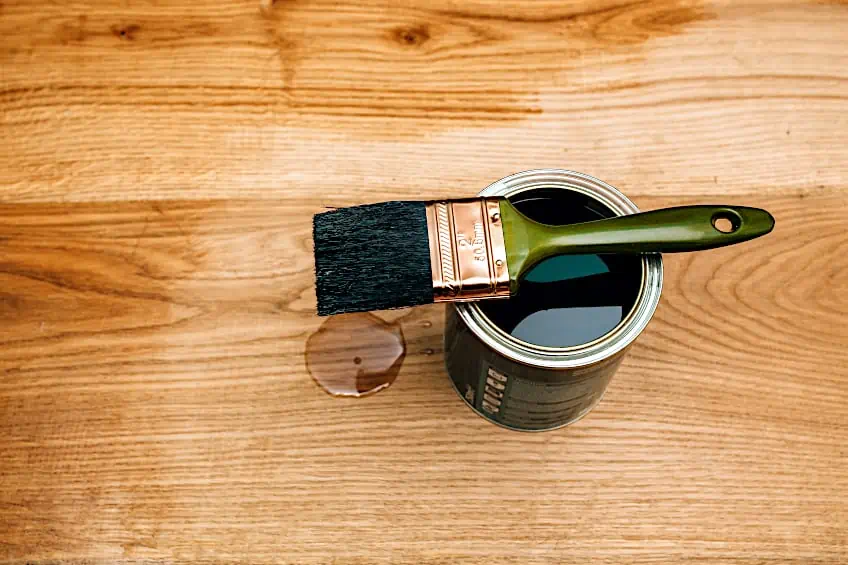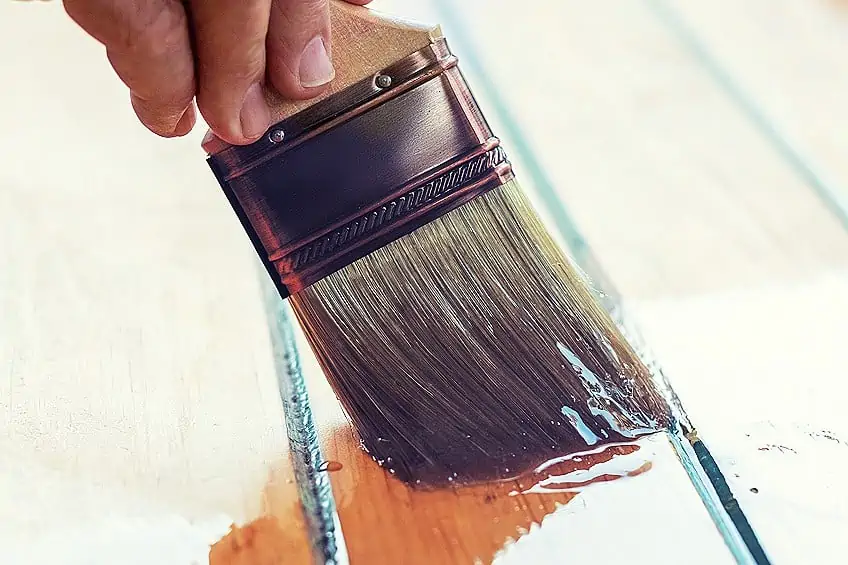How to Remove Polyurethane From Wood – The Best Poly Strippers
This post may contain affiliate links. We may earn a small commission from purchases made through them, at no additional cost to you.
When it comes to extending the life of wood, polyurethane is among the most often used finishing products. Most wood manufacturers use it in their products to ensure that their wood has a long life span while also providing a shiny appearance. However, every now and then, it may be necessary to remove polyurethane from wood. So, given its reputation for toughness and durability, how do you go about you removing polyurethane from wood? And what should you do if you have accidentally gotten some poly on your skin? This post will explain the different methods on how to remove polyurethane from wood as well as your skin without causing any damage.
Table of Contents
- 1 What Is Polyurethane?
- 2 Our Recommendations for the Best Polyurethane Removers
- 2.1 Our Best Overall Performance Recommendation: DUMOND Smart Strip Advanced Paint Remover
- 2.2 Our Budget-Friendly Recommendation: SUNNYSIDE CORPORATION Paint and Varnish Two-Minute Remover
- 2.3 Our Premium Recommendation: SUNNYSIDE CORPORATION Hi-Speed Ready to Strip Paint and Varnish Remover
- 2.4 Our Environmentally Friendly Recommendation: DUMOND CHEMICALS Smart Strip Pro Paint Remover
- 3 How to Remove Polyurethane From Wood
- 4 How to Get Polyurethane off Skin
- 5 Frequently Asked Questions
What Is Polyurethane?
Polyurethane is a liquid coating that may be put on wood to create a protective layer against moisture and other elements that may cause damage to wood. It transforms the wood’s surface into a long-lasting and easily-cleanable surface. Polyurethane comes in two different types: water-based and oil-based. These types have several differences including composition, durability as well as drying time.

Types of Polyurethane
As previously stated, polyurethane is available in two main formulations: water-based and oil-based formulations. The main difference between polyurethane is in how they are made. For instance, oil-based polyurethane is made by mixing ordinary finishing oils, such as linseed oil, with an organic compound that makes the oil condense and expand into bigger molecules. A fair general rule is that bigger molecules equate to more long-lasting coatings in terms of durability.

Oil-Based Polyurethane
A polyurethane that has an oil-based composition is often resistant to water infiltration. Aside from that, it is resistant to alcohol and other acids. Oil-based polyurethane is usually a mixture of finishing oils and organic compounds that create a durable coating. The disadvantage of using this polyurethane is that it becomes yellow over time.

Water-Based Polyurethane
A water-based polyurethane, on the other hand, is not water-resistant and may not be resistant to alcohol or other acids, depending on the manufacturer. In this kind of polyurethane, you will not find any finishing oils in the formula. Polyurethane from a water-based formula looks unchanged and does not become yellow over time.

The table below shows the general differences between water-based and oil-based polyurethane
| Water-based Polyurethane | Oil-based Polyurethane | |
| Durability | Very Good | Excellent |
| Dry to touch | 10 to 20 minutes | 2 to 6 hours |
| Flammability | Inflammable | Flammable |
| Cleaning agents | Water and soap | Mineral spirits |
| Odor | Low | High |
Our Recommendations for the Best Polyurethane Removers
There are a variety of alternatives available to make the process of removing Polyurethane from your wood less difficult and time-consuming. In this section, the best products for removing polyurethane are presented to assist in narrowing down the options. We present the top products in terms of performance, value, and price, as well as their pros and cons, to guarantee that you get the most appropriate polyurethane remover for your specific requirements.
Our Best Overall Performance Recommendation: DUMOND Smart Strip Advanced Paint Remover
If you want the best results when it comes to removing polyurethane from wood, this polyurethane remover is the perfect choice. This product is great for removing polyurethane from wood quickly and effectively. The product is a biodegradable remover that does not include any odor and does not contain any harmful compounds such as NMP or methylene chloride, among other ingredients.
The polyurethane remover does an excellent job of getting rid of Polyurethane from your wood in a fast and simple manner. Polyurethane may be removed using a brush, a roller, or a sprayer, depending on your preferences. Furthermore, washing this product is quite simple, and it does not need the application of several coats.
- Safe to use
- Get rid of multiple layers of Polyurethane very easy
- Free of any odors
- You can use brushes, rollers, or sprayers to apply
- Good value for money
- Does not provide great coverage
Our Budget-Friendly Recommendation: SUNNYSIDE CORPORATION Paint and Varnish Two-Minute Remover
This polyurethane remover works best when removing numerous layers of polyurethane in a single application. The remover features a non-flammable formula that is free of any methylene chloride and is safe to use. The odor is not overpowering, and it is efficient in its application. Furthermore, it has the capability of covering a surface area of up to 100 square feet. Aside from wood, the remover is effective on a variety of other surfaces and may be used to remove paint, shells, epoxy, lacquer, and varnish.
- Easy to apply
- Acts within two minutes
- It provides excellent coverage.
- Safe to use and free of methylene chloride
- Messy to use
Our Premium Recommendation: SUNNYSIDE CORPORATION Hi-Speed Ready to Strip Paint and Varnish Remover
This is a good alternative for anybody who has to do their task in a short amount of time. The product makes use of a solution that is both environmentally friendly and low in odor. This is packaged in a spray bottle therefore you do not have to use brushes or rollers to apply to the surface making it highly convenient.
- Cleaning is easy
- Formula with a mild odor
- A formula that is safe for the environment
- Convenient Option
- Takes longer to work
Our Environmentally Friendly Recommendation: DUMOND CHEMICALS Smart Strip Pro Paint Remover
This is a biodegradable option that does not include any volatile organic compounds (VOCs) in its composition. This makes it very simple to use the product near plants and animals. No odor is produced by the recipe, and it is a water-based formulation that does not include any harsh chemicals or solvents. Aside from that, it is quite effective in removing numerous coats of Polyurethane off wood surfaces.
- It does not include any volatile organic compounds (VOCs).
- Water-based formula
- There are no harsh solvents or chemicals in this product.
- It is effective for eliminating many layers.
- Requires extensive application for absorption
How to Remove Polyurethane From Wood
The procedure for removing polyurethane is the same whether the polyurethane is being removed from furnishings, doors, or even flooring. When removing polyurethane, you might use chemicals or sandpaper to do the task. Sanding is a technique that does not need the use of any chemicals. Unfortunately, it becomes quite time-consuming and generates a significant amount of dust.

Prepare the Surface
When it comes to removing polyurethane from wood, preparation is critical to the process. First and foremost, you’ll want to make sure the environment is protected. To remove polyurethane effectively using a stripper, you must first safeguard the surrounding environment. This includes the floor, your door hinges, and other components of your home or business.

Make sure you put on protective equipment such as a respirator, gloves, and safety goggles after that to avoid getting hurt. You must also be in a place that is adequately ventilated.

Apply the Stripper
The next step is to apply the stripper. Check to determine whether you need to use a brush, a roller, or a spray to apply the stripper before commencing. If you are using a brush, use an old brush because you may have to throw the brush away. In general, a chemical-based polyurethane stripper performs better than water-based polyurethane strippers. However, they may contain toxic chemicals. With a water-based stripper, you may have to re-apply them for effective results.
Ensure that you apply the stripper generously and that the whole polyurethane area is completely coated with the stripper in a thick layer when applying the stripper.

Scrub and Scrape the Surface
You should brush and scrape the surface of your wood if you see that the polyurethane has started to pucker, blister, or peel. A paint scraper may be used to remove and scrape the polyurethane off of the wood surface without damaging it. Keep in mind that you should scrape along the direction of the grain to avoid harming the wood.

A small wire may be used to scrape regions that are difficult to reach with a scraper. If you see that certain spots have not been scrapped completely, you may use fine-grit sandpaper to finish them off. You may need to reapply the stripper to certain spots and then repeat the processes outlined above.

Clean Up the Surface
The final step involves cleaning the surface. Cleaning is simple and can be accomplished with just water if using a water-based polyurethane stripper. If you want to refinish the wood with a stain and varnish, you need to give the whole surface moderate sanding to provide a smooth finish.

Tools Needed for Removing Polyurethane
There are numerous items that you will need to utilize to remove Polyurethane from wood. Floor scrapers, fine-grit sandpaper, chemical remover, gloves, and safety goggles are among the tools you’ll need. These will aid you in the removal of polyurethane from wood buildings with relative ease. This will, however, need a great deal of patience on the part of the user.
What Is the Best Way to Remove Polyurethane From Wood Without Using Chemicals?
It is also possible to remove polyurethane from wood without the use of chemicals. The use of homemade remedies such as water, baking soda, cornstarch, and other ingredients is just one of the ways of removing polyurethane from wood. The following are the steps to follow to remove Polyurethane from wood without using chemicals.

Make the Varnish Removal Mixture
Begin by boiling four cups of water. Next, you should perfectly mix one cup of cornstarch with half a cup of cold water. Following that, put 3/4 cup baking soda and one tablespoon vinegar to your 4 cups water in a container and mix well. Stir everything together, and afterward put in the cold water plus cornstarch to finish it off.

Apply the Mixture to the Furniture
To apply the mixture to your furniture, you may use cloths or paintbrushes. Start by covering the furniture with the mixture and then allow it to rest for some minutes.

Scrub the Surface
You should use stripping pads or wire brushes to scrub the surface of your furniture. Make sure to add some pressure when scrubbing the furniture. After you have eliminated the polyurethane from your furniture, you’ll be able to sand it down. Please keep in mind that you may omit the cleaning phase, however sanding will be substantially faster if you do not skip that step.

Sand the Furniture
To sand your furniture, you must use 60-grit sandpaper and keep sanding until you eliminate almost all the color from your wood and you can see the natural wood. This will help in restoring the smoothness of the furniture. To achieve a very smooth appearance, use 120-grit sandpaper as a finishing touch. Keep sanding until you reach the smoothness you want.

Clean the Surface
Eliminate any residual sawdust from your work surface by wiping it down. Once the surface has been thoroughly cleaned, you may begin refinishing your furniture. You may refinish the furniture with varnish or stain, just make sure that it is well sanded.
How to Get Polyurethane off Skin
Sometimes, polyurethane can get on your skin. Learning how to clean polyurethane off your skin is essential as some kinds of polyurethane may contain harmful substances. There are different methods on how to get polyurethane off skin based on the type of polyurethane that you are using. There are a variety of goods that may be employed, as well as several home cures that you can experiment with.

If you want to remove polyurethane from your skin, you could try using mineral spirits or denatured alcohol as a solvent. You should first wet a cotton swab in olive oil then apply directly to the sticky regions. After that, use a clean cloth, gently massage the polyurethane from your skin till the varnish comes off. You might also try using peanut butter, vegetable oil, or a polyurethane stripper derived from soy to remove it from your skin. Make sure to wash your hands with soap and warm water at the end of the day.

Polyurethane on your skin is very dangerous and may cause some effects including skin irritation and inflammation. As a result, you must use gentle solutions to ensure that you do not irritate your skin even more. That is also the reason oily materials are chosen over corrosive compounds such as mineral spirits or paint thinner, which are often found in paints. In this case, examples of oil-based products are baby oils, creamy peanut butter, vegetable oils, as well as mineral oils.
Polyurethane is one of the most widely used protective materials in the wood industry, and it is used by many different companies. It aids in the prevention of the wood from fading and wearing out in a short amount of time, which is beneficial. This article revealed how to quickly and simply remove Polyurethane off wood, allowing you to save both time and money in the process.
Frequently Asked Questions
How to Clean Polyurethane?
Knowing how to clean polyurethane before you begin using it is very important. When it comes to cleaning Polyurethane, there are a variety of options available. You must, however, avoid cleaning the polyurethane with ammonia-based solutions or alcohol, since these can damage the surface. Instead, you should choose detergents that are made from natural ingredients. As an alternative, you may just wash out the surfaces with a damp towel.
How to Get Polyurethane off Skin?
When it comes to removing polyurethane from the skin, it is preferable to use natural oils since they are more effective and safer. For instance, you may use vegetable oil or peanut butter by merely massaging it on your skin. This aids in relaxing and lifting your skin, allowing the polyurethane to be removed from your body.
What Is the Most Effective Method of Removing Polyurethane From Wood?
The most effective method of removing polyurethane from wood is to use chemical stripping agents. These are effective and do not cause any harm to your wood.
How to Remove Polyurethane From Wood?
Polyurethane from wood may be removed with or without the use of chemicals, depending on the situation. Comparing working with chemicals to working without chemicals, such as sanding, which is a time-consuming operation, using chemicals is much quicker.








